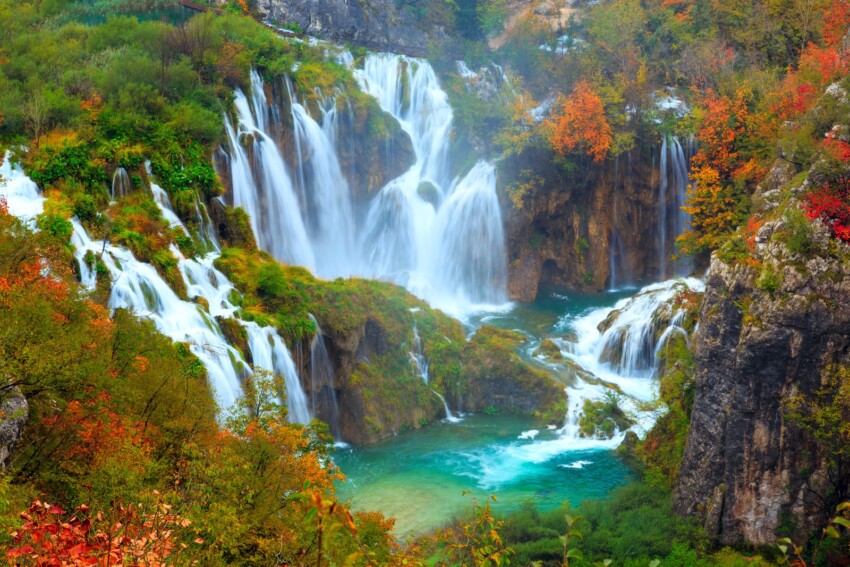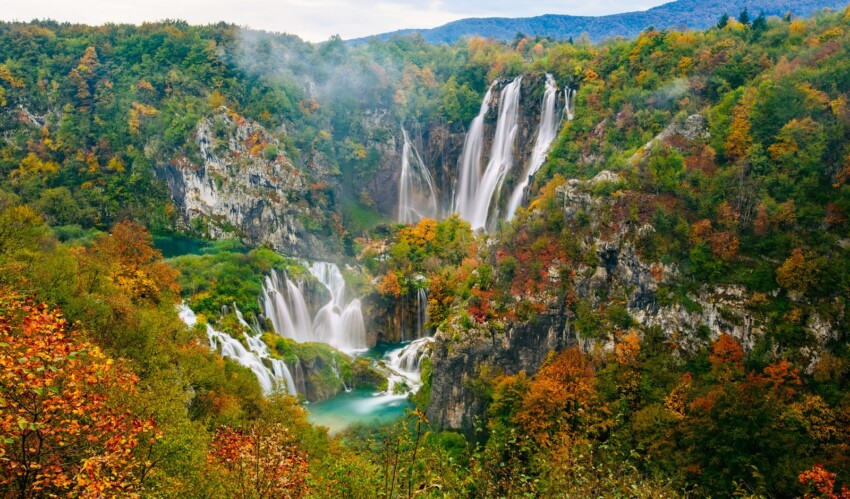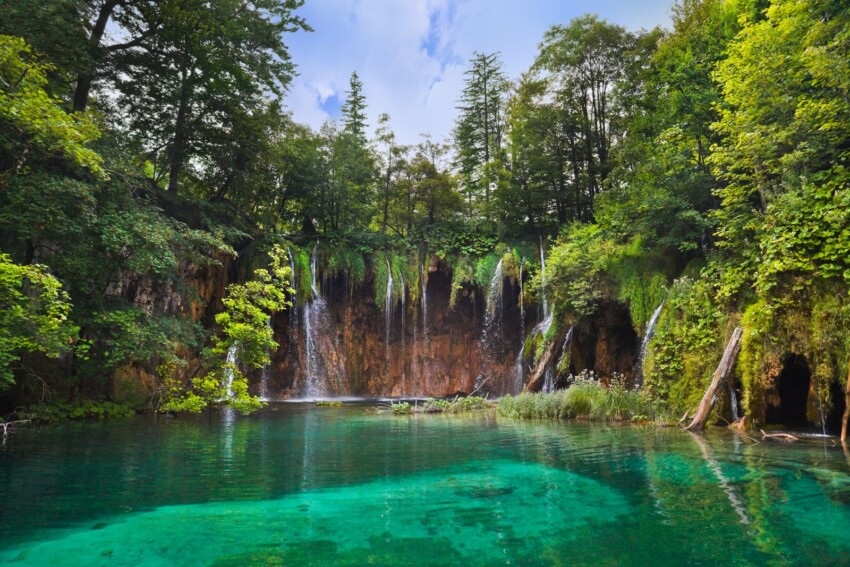
Although Croatia’s image as a tourist destination is linked to beaches and islands, the country’s most visited attraction has less to do with the sea and more to do with… lakes.
The Plitvice National Park is simply stunning, with its 16 lakes forming waterfalls and rapids surrounded by forests rich in vegetation and wildlife. The waterfalls are what most linger in visitors’ memories, so much so that for many, this place is known as ‘the Plitvice waterfalls‘.
The vivid green of the vegetation and the emerald green of the lake water, sometimes tinged with blue, blue or grey, are the dominant tones of this extraordinary natural scenery.
You can explore it on foot by walking along an 18 km-long system of wooden footbridges that follows the contours of the lakes and streams, allowing you to walk right above, below and through the sometimes wild and noisy, sometimes sly mass of water.
Immerse yourself completely in this natural ecstasy, allow yourself to be amazed by the thousands of shades of water in the lakes, the roaring force of the waterfalls and the amusing zigzagging of the wooden footbridges.
The Plitvice Lakes are an attraction suitable both for families with children and the elderly, who will choose the easier and more scenic trails, and for sportsmen and active holiday enthusiasts, for whom more demanding hiking and cycling routes are available.
The Plitvice waterfalls play a prominent role in Croatian history. It was here, in March 1991, that the bloody civil war that led to the country’s independence began.
The Serbs took control of the park’s administrative offices and held it until the end of the war, plundering the entire Plitvice region and turning the park’s hotels into barracks.

The Plitvice Lakes National Park is open all year round and each season offers different reasons to visit. With a full day at your disposal, you can enjoy a good portion of the park, but it is also possible to visit in half a day, perhaps as an excursion from Zadar or Zagreb.
Summer is naturally the season with the greatest influx of tourists, but it is also when the vegetation is at its most beautiful.
Spring is recommended for its mild temperatures and waterfalls, which abound in water at this time.
In autumn, the colours of the leaves are particularly striking and the park takes on a gently romantic air.
If you don’t mind the cold, come here in winter: on sunny days, silvery reflections shine from the frozen lakes and the white snowy landscape is particularly impressive. In this season the influx of tourists is at a minimum and you can enjoy extraordinary peace and serenity, as well as find good hotel deals.

The park area includes the lake system, divided into an upper and lower part, forested areas, caves and grottos.
There are 16 lakes that make up Plitvice Park, divided between 12 upper (Gornja Jezera) and 4 lower (Donja Jezera). Of course, they are all beautiful, but some deserve more prominence, especially the upper ones.
The largest lake in the Plitvce Park is Lake Kozjak, 3 km long with a small island in the middle, marking the division between the lower and upper lakes, while Galovac is generally considered the most beautiful lake.
The spectacular colour of the lakes changes from emerald green to turquoise, but can sometimes also be blue or dark grey. The colour of the water in the lakes depends on many factors, such as the amount of microorganisms present, the angle of the sun’s rays and whether or not there is mud in the water.
Whatever the colour of the water at the time of your visit, the visual impact is always extraordinarily impressive. Plitvice is the perfect place for breathtaking photographs, but remember that you will need a permit to take photos for commercial use.
If you have seen pictures of the park in a guidebook or tourist magazine, you will not be disappointed when you stand in front of the real waterfalls. You don’t need Photoshop to make photographs of these places beautiful, nature already has everything!
The Upper Lakes are located in a Dolomite valley, surrounded by dense forests, separated by natural travertine barriers and connected by mighty waterfalls. There are twelve in all: Prošćansko, Ciginovac, Okrugljak, Batinovac, Veliko, Malo, Vir, Galovac, Milino, Gradinsko, Veliki Burgetand Kozjak.
Lake Prošćansko is the first of the upper lakes, and the one situated at the highest altitude: a good 638 metres above sea level. It is one of the largest lakes in the park, with a surface area of 68 hectares, over 2 kilometres long and up to 400 metres wide. The water has a dark green colour, due to the lake’s depth of up to 37 metres.
Lake Prošćansko is fed by the waters of the Crna and Bijela rivers, the main tributaries of the Matica River. The left bank of the lake is a protected area, where access is prohibited.
Immediately below Lake Prošćansko lies Lake Ciginovac, at an altitude of 626 metres above sea level. It, too, is part of the upper lake system, and occupies an area of 7 hectares, with a maximum water depth of 11 metres and a dark green colour.
The most interesting part of Lake Ciginovac to visit is the series of collapsed travertine blocks in the south-eastern part. A barrier has formed at the end of the lake, where the water flows down to Lake Okrugljak.
Lake Galovac, with its 12.5 ha surface area, is the third largest lake in the entire Plitvice lake system; it lies at an altitude of 582 metres above sea level and has a maximum depth of 24 metres. It is part of the Upper Lakes, and is fed by the waters of Lakes Batinovac, Vir and Malo.
On the northern shore, just below the Stubica hills, Dolomia rocks can be seen among the trees, while on the eastern shore of Lake Galovac are the Prstavci waterfalls, which fall into the lake through travertine barriers up to 20 metres high.
Lake Gradinsko lies at an altitude of 554 metres above sea level, covers an area of 8 hectares and has a maximum depth of only 10 metres. It has a very distinctive L-shape and is part of the upper lake system. The name Gradinsko comes from the Croatian word ‘gradina‘, meaning ‘fortified town‘, which once existed on the hill between this lake and Lake Kozjak.
Lake Gradinsko is very interesting due to the colour of its waters, which vary from light green/turquoise to milky white in the shallower areas. The deeper areas, on the other hand, have dark green water. At the end of the lake, the water flows into Lake Kozjak via a series of low barriers and small waterfalls.
Lake Kozjak is the last of the upper lakes, and at the same time the largest lake in the entire Plitvice Park, with an area of 82 hectares that stretches over a maximum length of 2.35 km and a maximum width of 60 metres. It lies at an altitude of 534 metres above sea level, and was formed in ancient times by the merger of two lakes; the barrier dividing them is still visible today, at a depth of around 4 metres, just across the bay of Matijaševića Draga.
In the centre of the lake there is also a small islet called Štefanijin otok, near which there is a pier where it is possible to board a small boat that takes tourists to the upper and lower lakes.
The lower lakes extend from the main entrance; they are smaller and surrounded by sparse vegetation. There are four of them: Milanovac, Gavanovac, Kaluđerovac and Novakovića Brod.
Indispensable elements of the Plitvice lake system are the watercourses that make up its water supply: of these, the two main ones are the White River and the Black River, which join into a single watercourse south of Lake Prošćansko.
The water from the 16 lakes then flows into the Korana River, which continues its course along a gorge and is a popular destination for rafting excursions.

During your visit to the Plitvice Lakes you can see countless streams and springs form the most diverse waterfalls and rapids, from small cascades to the highest waterfall in Croatia, the Great Waterfall, a full 78 metres high.
The Plitvice Lakes National Park also includes a number of wonderful waterfalls:

To visit the park in its entirety would take at least three days, but fortunately there are plenty of signposted routes by which it is possible to see a good portion of the park even in just a few hours.
Suggested walking routes range from a leisurely 3.5 km walk to a challenging 18 km trek, with durations ranging from two to eight hours: you can choose which path to take depending on the time you have available and your fitness level. There are also mountain bike trails.
There are several ways to visit the Plitvice Park: in addition to the entrance ticket to be purchased at the ticket offices, you can discover the Park with a guided tour, perhaps with a one-day transfer directly from the main Croatian towns.
If the idea of visiting the park on your own does not convince you, you can join one of the half-day or full-day guided park tours that are offered in several languages.
If you are based in larger cities such as Split, Zadar or Zagreb, you can visit Plitvice with a day trip that includes the ticket, guided tour and transfer.
There are numerous services within the Plitvice National Park that will make your visit easier to organise and more enjoyable.
Facilities include car and camper van parking (for a fee), toilets, restaurants and cafes, and souvenir shops.

If you want to extend your visit to the waterfalls or treat yourself to a dreamy night immersed in breathtakingly beautiful nature, stay in one of the hotels in the Plitvice park.
There are three in total, the first of which opened as early as the late 19th century. The Plitvice Lakes hotels were destroyed during the civil war in the former Yugoslavia and later rebuilt: today they are modern hotels with all the comforts and services.
Hotels, room rentals and campsites have been opened in the vicinity of the park over the years, so if you want to stay in the area you should have no problem finding accommodation. If you are travelling in the summer, it is advisable to book in advance, especially if you are a family or a group.
You can get to Plitvice Lakes National Park by bus from Zadar, Zagreb, Rijeka and other Croatian towns – the journey can take several hours, depending on the town of departure.
With a private or rented car you can reach the park in less than two and a half hours from Rijeka and three from Split.
Another option is to join an organised tour: you will find one departing from almost every Croatian tourist resort. We have selected the best tours for you.
Plitvice National Park is located in the mountainous region of Lika in central Croatia. It is located about 100 km south of Zagreb and about 200 km from Split.